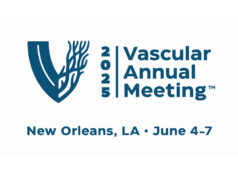
Paolo Perini, MD, of the University Hospital of Parma, Parma, Italy, told the audience of SVS ONLINE (June 20–July 2) that explantation of an infected abdominal aortic endograft is associated with high postoperative mortality and poor long-term survival. Furthermore, there was a high rate of reinfection.
According to Perini and colleagues, infection of an abdominal aortic endograft is a rare but “devastating complication” that is associated with high mortality. He told the SVS ONLINE audience that the aim of the present study—a multicenter review of endograft explantations performed over a 20-year period (1999–2019)—was to analyze factors “that may have influenced 30-day mortality, 30-day morbidity, and long-term survival.”
The investigators identified 257 patients who had undergone (abdominal aortic) endograft explantation at 11 centers over the study period. Of these, 49 (19%) had an infected endograft. “The mean age of patients was 73 years and there was a clear male preponderance [90% of patients]. This was a high-risk population. In fact, 86% of patients had an American Society of Anesthesiologist (ASA) score higher than 3,” Perini observed.
He added that one finding was that explantation for infection “generally occurred” earlier than explantation for endoleak correction (13 vs. 46 months, respectively; p<0.001). Furthermore, 35% of patient had previously undergone endovascular correction. This finding did not mean prior endovascular correction was a risk factor for infection because, according to Perini, “explantation for other reasons presented a similar rate of endovascular correction.”
However, any intervention could be a factor in a patient developing an infection. He told Vascular Connections: “The fact that explantations for infection are performed earlier than explantations for other reasons (13 vs. 46 months) may indicate the infection often occurs during the first year after endovascular aneurysm repair (EVAR). Thus, utmost attention should be paid during this period, especially in case of invasive maneuvers (any invasive maneuver: cardiac, urologic, dental… ). So even though not demonstrated in the present study, endovascular reinterventions may potentially play a role in the development of ‘late’ endograft infections.”
All patients underwent complete endograft explantation, with 63% subsequently undergoing anatomic reconstruction and 37% undergoing extra-anatomic reconstruction. While anatomic reconstruction was more common overall, Perini noted that extra-anatomic reconstruction was “a common solution for patients operated on in an urgent setting [57% of patients were urgent cases].”
In terms of the infection itself, 22% of infections were found intraoperatively. Additionally, the most commonly identified micro-organisms were Gram positive and multiple causative agents were found in two thirds of cases. “Whenever possible, we started antibiotic therapy preoperatively in agreement with infectious disease specialists. Postoperatively, targeted antibiotic therapy was continued for at least three weeks,” he explained.
At 30 days, mortality was 25% and this rose to 35% when in-hospital mortality was taken into considerations. Perini commented: “We did not find any specific risk factors for higher mortality. The presentation of aortoenteric fistula [40% of cases] was associated with a higher mortality rate but the difference [compared with other presentations] was not statistically significant. Morbidity rates were high, especially in terms of renal injury [27%], respiratory failure [33%], and gastrointestinal complications [18%].”
During long-term follow-up (mean 31.2±47.8 months), there were four aneurysm-related deaths and 20% of patients went on to have another infection. The one-year and five-year survival rates were 57% and 32%, respectively, and these rates were significantly lower than for patients who underwent explantation for another reason (83% and 65%, respectively; p=0.035). One-year survival rates were also significantly lower in patients who underwent extra-anatomic reconstruction than those who underwent anatomical reconstruction: 33.3% vs. 72.2%, respectively; p=0.0014.
Perini noted to Vascular Connections that while a substantial proportion of patients who underwent extra-anatomic reconstruction were urgent cases (i.e. high-risk), the procedure itself may have contributed to the lower survival rate. “Regarding non-urgent patients who underwent extra-anatomic reconstructions, complications were frequent and severe. Aside from a patient who died during the postoperative period, severe complications occurred in four out of five patients: one acute limb ischemia due to axillobifemoral bypass thrombosis, two had a reinfection, and one developed an aneurysm of the aortic stump,” he explained.
Perini concluded that explantation of an infected endograft was “technically challenging” and was associated with “high postoperative mortality and morbidity rates”. He also noted that long-term survival was “poor.”












